Topics  God & YHWH God & YHWH 
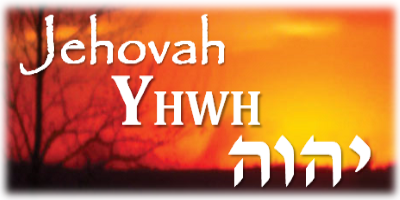
What is God's name in Hebrew?
By Jeff A. Benner
If you have been searching for the “true” pronunciation of the name of God, you have probably discovered that there are many different sites providing different pronunciations. The reason for this is simple; there is no possible way to know, with 100% accuracy, how this name was originally pronounced. Let me explain.
The Four Hebrew Letters
The name of God, often referred to as the Tetragrammaton (a Greek word meaning “four letters”), is written with four Hebrew letters: Yud, Hey, Vav and the letter Hey again. One of the oldest known examples of this name is found in the Temple Ostraca (Note that Hebrew is read from right to left).
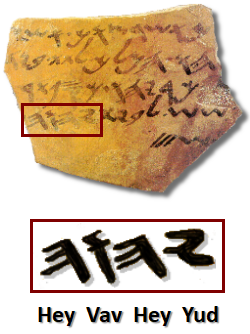
This style of Hebrew Script is called Paleo-Hebrew and was in use by the Hebrews from about 1000 B.C and into the first century A.D. Now let’s examine the pronunciation of each of these letters.
The Yud
This letter is pronounced with a “Y” sound, as in the word “yellow.” Most people will be familiar with the transliteration of “Jehovah,” which begins with the letter “J.” When the letter “J” was first introduced about 500 years ago, it originally had the same “Y” sound as the Hebrew letter Yud, but later changed to the “Dg” sound we are familiar with today. It should be noted that in Slavic languages the letter “J” still retains the “Y” sound to this day.
Two Hebrew letters, the Yud and the Vav, both of which appear in this name, were frequently used as a consonant and a vowel. When the letter Yud appears at the end of a syllable it has an “I” (ee) sound. But as this letter appears at the beginning of a syllable in this name, it will use the consonantal sound “Y.”
The Hey
This letter, which appears twice in the name, has an “H” sound as in “hello,” but when it is at the end of a syllable it will be silent, like in the name “Judah.”
The Vav
In Modern Hebrew this letter is pronounced with a “V” sound as in “vote.” However, there is some debate on this among scholars and many believe that this letter originally had a “W” sound. This is one of those letters that would take a vowel sound when at the end of a syllable and would have an “O” or “U” sound.
Let’s take another look at the name in the Temple Ostraca with the possible sounds for each letter.
YHVH
YHWH
YHOH
YHUH
Syllable Breaks
Where the syllable break is placed in the name will determine if the letter Vav is used as a consonant or vowel. Hebrew likes to have a closed syllable (Consonant-Vowel-Consonant) at the end of a word. Other syllables may be a closed or open (Vowel-Consonant) syllables. The only way that this name can end with a closed syllable is if the letter Vav is the beginning of the final syllable. Therefore, the Vav must be a consonant (V or W). This leaves us with four possible syllable formations.
Y-H-VH
Y-H-WH
YH-VH
YH-WH
Added Vowel Sounds
You will notice that we are still missing some vowel sounds. With the exception of the letters Yud and Vav, Hebrew was written without vowels and they were simply “known” to the readers of the day, but may have been lost to us over time (more about this in a moment). Now our possible pronunciations for this name are many. Here are just a few of the possibilities:
Ya-Ha-VaH
Ye-He-VeH
Ya-He-VaH
Ya-Ha-WaH
Ye-He-WeH
Ya-He-WaH
YaH-VaH
YeH-VeH
YaH-VeH
YaH-WaH
YeH-WeH
YaH-WeH
Introduction of the Aramaic Alphabet
While the Paleo-Hebrew alphabet continued to be used in a limited basis into the first century A.D., around the fourth century B.C. Israel began using the Aramaic alphabet in place of the Paleo-Hebrew, such as can be seen in most of the Dead Sea Scrolls (while the vast majority of these scrolls use the Aramaic alphabet, a few were written in Paleo-Hebrew).
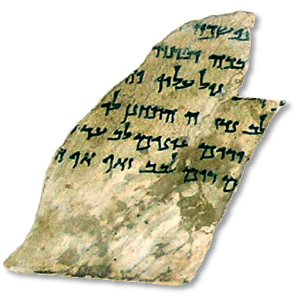
Not always, but more often than not, when they were writing with the Aramaic alphabet, they would still use the Paleo-Hebrew alphabet for the name of God, showing us that they still considered the name of God and the Paleo-Hebrew alphabet sacred.
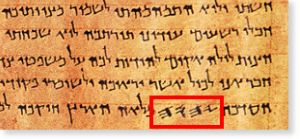
Whether Hebrew was written in Paleo-Hebrew or Aramaic, the pronunciation of Hebrew remains the same and therefore the introduction of the Aramaic alphabet has no bearing on the pronunciation of the name of God.
Introduction of the Nikkudot
Around 1000 A.D. a group of Jewish scribes called Masorites, developed a system of dots and dashes, called nikkudot (singular: nikkud), that we’re placed above and below the letters to represent all the vowel sounds. These inserted vowels most likely provide to us the pronunciation of Hebrew at that time. Below is the Hebrew text of Genesis 1:1 written with the Aramaic alphabet.

And here is the same text, but with the Nikkudot added.

As I mentioned previously, the ancient pronunciation of Hebrew may have been lost to us over time, but it can be assumed that the vowel sounds inserted into the text provide us the pronunciations of Hebrew at that time, 1000 A. D. But the question is, “Is the traditional pronunciation of 1000 A.D. the same as it was in 1000 B.C.?” Unfortunately, there is no way to answer this question.
In the Masoretic Hebrew texts, which include the Nikkudot, we find six different spellings, for the name of God.
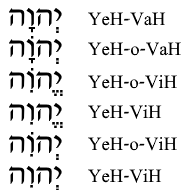
Was the name of God pronounced, these six different ways? Probably not. For over 2,000 years Jews have forbidden anyone from pronouncing the name. So, rather than placing the correct Nikkudot into the four-letter name, they placed the Nikkudot from the words אֲדֹנָי (Adonai- Lord) or אֱלֹהִים (Elohiym - God) into the four letters of the name.
Conclusion
The bottom line is that there are many possibilities for the original pronunciation of the name and all we can do is make educated guesses. I am often asked what I believe the original pronunciation was, and my educated guess is YiH-WeH (see my video titled, This is my Name.
Related Pages by Jeff A. Benner
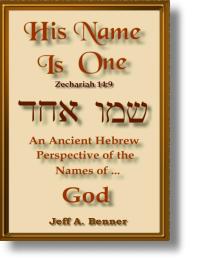 | | His Name is One (Book)
An examination of the Hebrew words and names used for God and their interpretation from an ancient Hebrew perspective. |
 | | The Way of Yahweh (Article)
In the Bible, the way to God is described as a journey, a path leading to a destination. |
|












